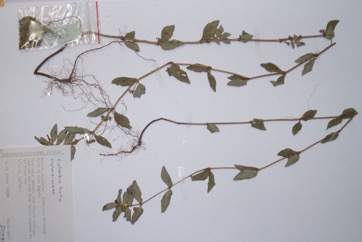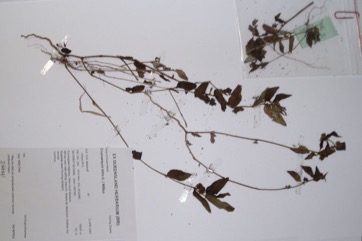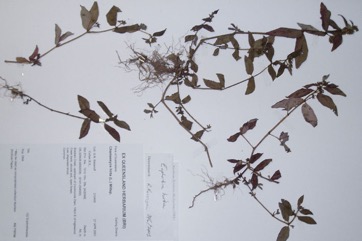Asthma plant

It is a tropical plant. It will grow on most soils. It prefers an open sunny position. It is damaged by drought and frost. In Papua New Guinea it grows from near sea level to about 2,000 m altitude. In Argentina it grows below 800 m above sea level. In Northeastern India it grows between 1,200-1,600 m above sea level. It grows in wetlands. It can grow in arid places. In Sichuan and Yunnan.
Also known as:
Aankle jhar, Aidinono, Amampatchaiarisi, Ammanpacharisi, Barokheruie, Bidarie, Choti dudhli, Co sua, Da ru cao, Dudhe ghans, Dudejhar, Dudali, Dudeleka, Dudeli, Dudhi, Dudhia, Gakhiroti bon, Karisilanganni, Kiawa-ame, Kikula ntedi, Kiruthona, Kula ntese, Mothidudhi, Midum-an, Namaito, Nashrai khoro, Nasraikoro, Nayeti, Nelapalai, Ngotoindika, Nyama-toka, Palcheera, Reddinanabrolu, Reddivaari nanabaalu, Tamu ao, Taquelpolhe, Washah, Yowan
Synonyms
- Chamaesyce hirta (L.) Millspaugh
- Chamaesyce rosei Millsp.
- Euphorbia pilulifera auct. non L.
- and several others
Edible Portion
- Leaves, Fruit, Flowers, Vegetable, Tea
Where does Asthma plant grow?
Found in: Africa, Argentina, Asia, Australia, Bahamas, Bangladesh, Barbados, Benin, Bermuda, Bolivia, Botswana, Brazil, British Indian Ocean Terr., BIOT, Burkina Faso, Cameroon, Cape Verde, Central Africa, Central America, Chile, China, Christmas Island, Chuuk, Colombia, Comoros, Congo DR, Costa Rica, Côte d'Ivoire, Cuba, Dominican Republic, East Africa, East Timor, Egypt, El Salvador, Equatorial-Guinea, Eswatini, Ethiopia, Fiji, FSM, Gabon, Gambia, Ghana, Guam, Guatemala, Guiana, Guianas, Guinea, Guinée, Guinea-Bissau, Guyana, Haiti, Hawaii, Himalayas, Honduras, India, Indochina, Indonesia, Iraq, Ivory Coast, Jamaica, Japan, Kiribati, Liberia, Madagascar, Malawi, Malaysia, Maldives, Mali, Marquesas, Mauritius, Mozambique, Myanmar, Namibia, Nepal, New Caledonia, Nicaragua, Niger, Nigeria, North Africa, Northeastern India, Oman, Pacific, Pakistan, Panama, Papua New Guinea, PNG, Paraguay, Peru Philippines, Puerto Rico, Qatar, Reunion, Rwanda, Samoa, Saudi Arabia, SE Asia, Senegal, Seychelles, Sierra Leone, Socotra, Solomon Islands, Somalia, South Africa, South America, Southern Africa, Sri Lanka, Sudan, Suriname, Swaziland, Taiwan, Tanzania, Thailand, Timor-Leste, Tonga, Trinidad-Tobago, Tuvalu, United Arab Emirates, UAE, Pan tropical, United States, Vanuatu, Venezuela, Vietnam, West Africa, West Indies, West Timor, Yemen, Zambia, Zimbabwe
Notes: Plants have been used to treat bronchitis and asthma. The tips have also been eaten to treat diarrhoea. Plants often are self sown in cultivated land. There are about 2000 Euphorbia species. Most Euphorbias have sap which irritates the skin. It is high in proVitamin A.
Status: They are sold in markets.
Growing Asthma plant
Cultivation: Plants can be grown from seed or cuttings.
Edible Uses: Caution: All Euphorbias or spurges have irritating sap and many have chemicals that can cause cancer. The tender leaves and shoots are cooked as a vegetable. They should only be eaten in small quantities. They are also used to make a drink. The fruit are eaten raw. The flowers are eaten raw as a sweet. The young leaves can be stored for 3-4 days after harvesting.
Nutrition Info
per 100g edible portion| Edible Part | Energy (kcal) | Protein (g) | Iron (mg) | Vitamin A (ug) | Vitamin c (mg) | Zinc (mg) | % Water |
|---|---|---|---|---|---|---|---|
| Leaves | - | 4.7 | - | 62 | - | - | 78 |
Asthma plant Photos



References
Ajain, M., Ali, T., & Siddiqui, M.F., 2015, A Survey of Ethnobotanically Important Herbaceous Plants of Tehsil Jatoi,District Muzaffar Garh, Punjab, Pakistan. Int. J. Biol. Res., 3(2): 87-92, 2015.
Ambasta, S.P. (Ed.), 2000, The Useful Plants of India. CSIR India. p 213
Angami, A., et al, 2006, Status and potential of wild edible plants of Arunachal Pradesh. Indian Journal of Traditional Knowledge 5(4) October 2006, pp 541-550
Baro, D., Baruah, S. and Borthukar, S. K. 2015, Documentation on wild vegetables of Baksa district, BTAD (Assam). Scholars Research Library. Archives of Applied Science Research, 2015, 7 (9):19-27
Bodkin, F., 1991, Encyclopedia Botanica. Cornstalk publishing, p 463
Borrell, O.W., 1989, An Annotated Checklist of the Flora of Kairiru Island, New Guinea. Marcellin College, Victoria Australia. p 75
Brown, D., 2002, The Royal Horticultural Society encyclopedia of Herbs and their uses. DK Books. p 210
Burkill, H. M., 1985, The useful plants of west tropical Africa, Vol. 2. Kew.
Burkill, I.H., 1966, A Dictionary of the Economic Products of the Malay Peninsula. Ministry of Agriculture and Cooperatives, Kuala Lumpur, Malaysia. Vol 1 (A-H) p 994
Cowie, I, 2006, A Survey of Flora and vegetation of the proposed Jaco-Tutuala-Lore National Park. Timor-Lests (East Timor) www.territorystories.nt/gov.au p 47
Cribb, A.B. & J.W., 1976, Wild Food in Australia, Fontana. p 178
Dangol, D. R. et al, 2017, Wild Edible Plants in Nepal. Proceedings of 2nd National Workshop on CUAOGR, 2017.
Dansi, A., et al, 2008, Traditional leafy vegetables and their use in the Benin Republic. Genet Resour Crop Evol (2008) 55:1239–1256
Dobriyal, M. J. R. & Dobriyal, R., 2014, Non Wood Forest Produce an Option for Ethnic Food and Nutritional Security in India. Int. J. of Usuf. Mngt. 15(1):17-37
Dutta, U., 2012, Wild Vegetables collected by the local communities from the Churang reserve of BTD, Assam. International Journal of Science and Advanced Technology. Vol. 2(4) p 121
Flora of Pakistan. www.eFloras.org
Fowler, D. G., 2007, Zambian Plants: Their Vernacular Names and Uses. Kew. p 26
Grubben, G. J. H. and Denton, O. A. (eds), 2004, Plant Resources of Tropical Africa 2. Vegetables. PROTA, Wageningen, Netherlands. p 561
Henty, E.E., & Pritchard, G.S., 1973, Weeds of New Guinea and their control. Botany Bulletin No 7, Division of Botany, Lae, PNG. p 103
Henty, E.E., 1980, Harmful Plants in Papua New Guinea. Botany Bulletin No 12. Division Botany, Lae, Papua New Guinea. p 52, 54
Hossain, U. & Rahman, A., 2018, Study and quantitative analysis of wild vegetable floral diversity available in Barisal district, Bangladesh. Asian J. Med. Biol. Res. 2018, 4 (4), 362-371
Hussey, B.M.J., Keighery, G.J., Cousens, R.D., Dodd, J., Lloyd, S.G., 1997, Western Weeds. A guide to the weeds of Western Australia. Plant Protection Society of Western Australia. p 144
Hu, Shiu-ying, 2005, Food Plants of China. The Chinese University Press. p 510
Joshi, N., et al, 2007, Traditional neglected vegetables of Nepal: Their sustainable utilization for meeting human needs. Tropentag 2007. Conference on International Agricultural Research for Development.
Joshi, N. & Siwakoti, M., 2012, Wild Vegetables Used by Local Community of Makawanpur District and Their Contribution to Food Security and Income Generation. Nepal Journal of Science and Technology Vol. 13, No. 1 (2012) 59-66
Kar, A., et al, 2013, Wild Edible Plant Resources used by the Mizos of Mizoram, India. Kathmandu University Journal of Science, Engineering and Technology. Vol. 9, No. 1, July, 2013, 106-126
Karthi, Sathya, & Salome, 2014, Uncultivated Edible Greens from Small Millet Farms Tamil Nadu India. IDRC
Kumar, R. & Saikia, P., 2020, Wild edible plants of Jharkhand and their utilitarian perspectives. Indian Journal of Traditional Knowledge Vol 19 (2), April 2020, pp 237-250
Latham, P., 2004, Useful Plants of Bas-Congo province. Salvation Army & DFID p 128
Lazarides, M. & Hince, B., 1993, Handbook of Economic Plants of Australia, CSIRO. p 111
Li, D. et al, 2017, Ethnobotanical survey of herbal tea plants from the traditional markets in Chaoshan, China. Journal of Ethnopharmacology. 205 (2017) 195-206
Low, T., 1991, Wild Herbs of Australia and New Zealand. Angus & Robertson. p 89
Manandhar, N.P., 2002, Plants and People of Nepal. Timber Press. Portland, Oregon. p 228
Martin, F.W. & Ruberte, R.M., 1979, Edible Leaves of the Tropics. Antillian College Press, Mayaguez, Puerto Rico. p 192
Molla, A., Ethiopian Plant Names. http://www.ethiopic.com/aplants.htm
Murtem, G. & Chaudhrey, P., 2016, An ethnobotanical note on wild edible plants of Upper Eastern Himalaya, India. Brazilian Journal of Biological Sciences, 2016, v. 3, no. 5, p. 63-81
Narayanan Ratheesh, M. K. et al, 2011, Wild edible plants used by the Kattunaikka, Paniya and Kuruma tribes of Wayanad District, Kerala, India. Journal of Medicinal Plants Research Vol. 5(15), pp. 3520-3529
Narzary, H., et al, 2013, Wild Edible Vegetables Consumed by Bodo tribe of Kokrajhar District (Assam), North-East India. Archives of Applied Science Research, 5(5): 182-190
Paczkowska, G. & Chapman, A.R., 2000, The Western Australian Flora. A Descriptive Catalogue. Western Australian Herbarium. p 246
Pagag, K. & Borthakur, S.K., 2012, Wild edible wetland plants from Lakhimpur district of Assam, India. Pleione 6(2): 322 - 327
Patiri, B. & Borah, A., 2007, Wild Edible Plants of Assam. Geethaki Publishers. p 128
Peekel, P.G., 1984, (Translation E.E.Henty), Flora of the Bismarck Archipelago for Naturalists, Division of Botany, Lae, PNG. p 320, 319
Plants for a Future database, The Field, Penpol, Lostwithiel, Cornwall, PL22 0NG, UK. http://www.scs.leeds.ac.uk/pfaf/
Ramachandran, V. S., 2007, Wild edible plants of the Anamalais, Coimbatore district, western Ghats, Tamil Nadu. Indian Journal or Traditional Knowledge. 6(1) pp 173-176
Royal Botanic Gardens, Kew (1999). Survey of Economic Plants for Arid and Semi-Arid Lands (SEPASAL) database. Published on the Internet; http://www.rbgkew.org.uk/ceb/sepasal/internet [Accessed 16th April 2011]
Sakar, A. & Das, A. P., 2018, The traditional knowledge on edible wild leafy vegetables of Rabha Tribe in Duars of North Bengal: a potential reinforcement to food security. Pleione 12(2): 275 - 281. 2018.
Sarma, H., et al, 2010, Updated Estimates of Wild Edible and Threatened Plants of Assam: A Meta-analysis. International Journal of Botany 6(4): 414-423
Sasi, R. et al, 2011, Wild edible plant Diversity of Kotagiri Hills - a Part of Nilgiri Biosphere Reserve, Southern India. Journal of Research in Biology. Vol. 1 No. 2, pp 80-87
Sasi, R. & Rajendran, A., 2012, Diversity of Wild Fruits in Nilgiri Hills of the Southern Western Ghats - Ethnobotanical Aspects. IJABPT, 3(1) p 82-87
Seidemann J., 2005, World Spice Plants. Economic Usage, Botany, Taxonomy. Springer. p 152
Singh, H.B., Arora R.K.,1978, Wild edible Plants of India. Indian Council of Agricultural Research, New Delhi. p 39
Singh, P.K., Singh, N.I., and Singh, L.J., 1988, Ethnobotanical Studies on Wild Edible Plants in the Markets of Manipur - 2. J. Econ. Tax. Bot. Vol. 12 No. 1 pp 113-119
Sp. pl. 1:454. 1753
Sujanapal, P., & Sankaran, K. V., 2016, Common Plants of Maldives. FAO & Kerala FRI, p 124
Termote, C., et al, 2011, Eating from the wild: Turumbu, Mbole and Bali traditional knowledge of non-cultivated edible plants, District Tshopo, DRCongo, Gen Resourc Crop Evol. 58:585-618
Terra, G.J.A., 1973, Tropical Vegetables. Communication 54e Royal Tropical Institute, Amsterdam, p 46
Topp, J. M. W., 1988, An Annotated Check List of the Flora of Diego Garcia, British Ocean Territory. Atoll Research Bulletin No. 313
Tsering, J., et al, 2017, Ethnobotanical appraisal on wild edible plants used by the Monpa community of Arunchal Pradesh. Indian Journal of Traditional Knowledge. Vol 16(4), October 2017, pp 626-637
Vernon, R., 1983, Field Guide to Important Arable Weeds of Zambia. Dept of Agriculture, Chilanga, Zambia. p 44
von Katja Rembold, 2011, Conservation status of the vascular plants in East African rain forests. Dissertation Universitat Koblenz-Landau p 167
Wallace, P. A., Marfo, E. K., and Plahar, W. A., 1998, Nutritional quality and antinutritional composition of four non-conventional leafy vegetables. Food Chemistry 61(3) 287-291
Westerway, J., et al, 2018, Preliminary checklist of the naturalised and pest plants of Timor-Leste. Blumea 63:157-163
Wheeler, J.R.(ed.), 1992, Flora of the Kimberley Region. CALM, Western Australian Herbarium, p 605
Wild edible plants of Himachal Pradesh
World Checklist of Useful Plant Species 2020. Royal Botanic Gardens, Kew
Yuncker, T.G., 1959, Plants of Tonga, Bernice P. Bishop Museum, Hawaii, Bulletin 220. p 168